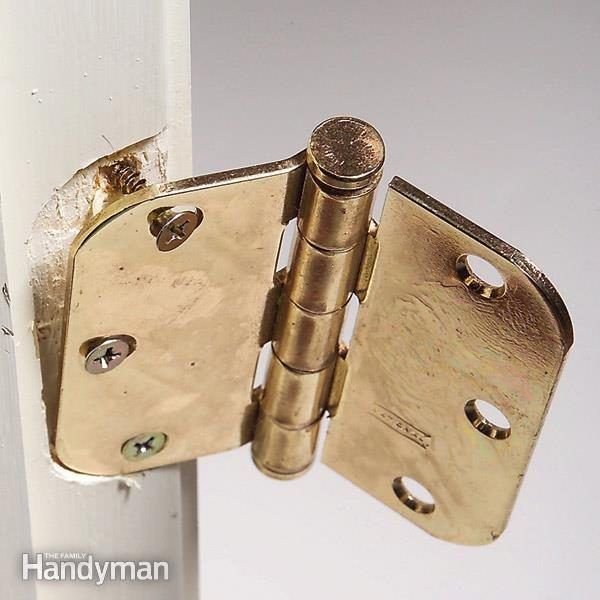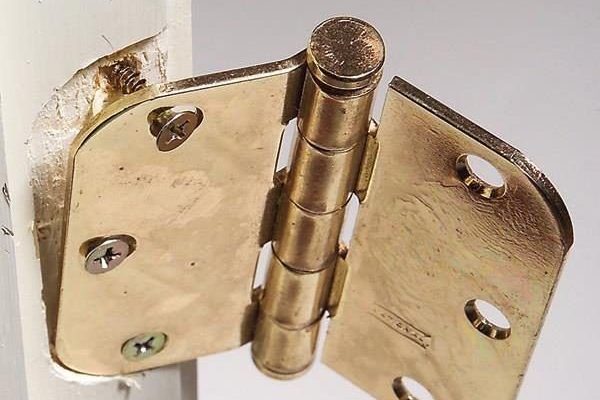
Let me set the scene: maybe you’ve got a classic wooden front door with a Schlage or Kwikset lock, or perhaps you’re working with a more modern steel door. The screws holding those heavy-duty hinges in place take a beating from the weather—rain, snow, humid summers, you name it. Before you know it, rust sets in. The trick isn’t just swapping out the screw—it’s choosing a replacement that won’t leave you repeating this chore year after year.
Spotting the Problem: Signs of a Corroded Hinge Screw
Let’s start with spotting the symptoms. A corroded screw in your exterior door hinge doesn’t always announce itself with a dramatic creak or a wobbly door, though sometimes it does. More often, you’ll notice things like a door that’s suddenly hard to open or close, a hinge that looks stained or “leaky” with reddish-brown rust, or screws with heads that look stripped, crumbly, or swollen. Sometimes you can even feel it—a grinding or gritty movement as you move the door.
Honestly, it’s easy to ignore these little changes at first. Maybe you think it’s just the weather or that the whole door is settling. But here’s the thing: when a screw corrodes, it loses its strength, and the hinge can start pulling away from the door or frame. This can mess up the alignment, make your lock hard to turn, or even put stress on the whole door. If you catch it early—before the screw snaps or the hinge warps—you’ll save yourself a major repair job down the line.
You might be wondering, “Is it just cosmetic, or is this really a problem?” It’s more than cosmetic. When rust is visible, it usually means the screw is already weakened underneath the surface. And if you have kids, pets, or a front door that gets a lot of use, you really want to be ahead of any potential failures—no one wants a front door that doesn’t close right.
Why Standard Screws Fail on Exterior Door Hinges
Let me explain why some screws just aren’t cut out for the job. Most exterior door hinges come with zinc-plated or plain steel screws. At first, they look fine—shiny, sturdy, easy to install. But after a few rainy seasons, humidity seeps in, and those screws start to corrode. Even with paint or sealant, it’s just a matter of time before moisture works its way into the tiniest cracks.
Here’s where it gets annoying: once rust starts, it spreads. Corroded screws leave stains on the door and the frame, and, if they break off, getting the remnants out can be a real pain. Sometimes, the head of the screw will snap off when you try to remove it, leaving the threaded part stuck deep in the wood or metal. If you’ve ever tried to drill out a rusted screw, you know it can go from a five-minute fix to a thirty-minute struggle.
So, why bother with standard screws at all? Well, they’re cheap and easy to find, but they just aren’t built to handle the beating an exterior door takes. If you’re already replacing a corroded screw, you definitely want to avoid repeating this cycle. That’s where stainless steel comes in—more on that soon.
Why Stainless Steel Screws Are the Best Choice for Exterior Doors
If you want a set-it-and-forget-it fix, stainless steel is the way to go. Stainless screws don’t just *look* nice—they’re built to fight off rust, corrosion, and even the salt air if you live near the coast. You might pay a little more upfront, but you’ll save on hassle (and possible door repairs) in the long run.
Here’s the science: stainless steel contains chromium, which forms a protective barrier against oxygen and moisture. That’s why it stays shiny and strong, even years after installation. You don’t have to worry about rain, snow, or wild temperature swings. And if you ever decide to repaint or refinish your door, you’ll be able to remove stainless screws without worrying about them snapping or falling apart in your hands.
You might be wondering which brands to look at. Grab a pack of stainless steel screws from your local hardware store—brands like Hillman, Spax, or GRK are solid bets. Just make sure you’re choosing screws labeled specifically as “exterior” or “stainless,” not just “zinc-coated” or “rust-resistant.” You want the real deal.
Bottom line: If you’ve already had a screw fail on you, don’t risk another round with standard hardware. Stainless steel is absolutely worth it for any door hinge exposed to the elements.
How to Remove a Corroded Hinge Screw (Step-by-Step)
This is where things get hands-on. Removing a corroded screw isn’t always straightforward, especially if it’s stuck or stripped. But with a little patience and the right approach, you can get it out without damaging your door.
- Gather your tools: You’ll need a screwdriver (manual or powered), a drill with a screw extractor bit, penetrating oil (like WD-40), and possibly pliers.
- Apply penetrating oil: Spritz a bit of oil right onto the screw head and let it soak for 10–15 minutes. This helps loosen any rust holding the screw in place.
- Try manual removal first: Use a screwdriver that fits snugly in the screw head. Apply firm, steady pressure and turn slowly. If it moves, awesome! Back it out carefully.
- If it’s stuck or stripped: Switch to a screw extractor. Drill a pilot hole in the center of the screw head, then insert the extractor and turn it counterclockwise. Most of the time, this pulls the screw right out.
- Remove the hinge if needed: If the screw still won’t budge, take the hinge off the door (removing the other screws first). With the hinge removed, you’ll have more leverage and access. You might need to grip the stuck screw with pliers and twist it free.
If you start feeling frustrated or the screw won’t budge, walk away and come back in a bit. Forcing it can strip the hole or damage your door. Patience beats brute strength every time.
Choosing the Right Replacement Screws for Exterior Door Hinges
Now that the old screw is out, it’s time to pick the right replacement. Here’s what matters most: strength, corrosion resistance, and a snug fit. You don’t want to mix and match random screws from your toolbox—especially on a security point like a door hinge.
- Length: Most standard exterior door hinges use screws that are at least 2 to 2.5 inches long. This length bites deep into the frame, adding stability and helping resist forced entry.
- Thread type: Use wood screws for wooden doors and frames, or metal screws if you’re working with a steel door. Stainless steel multi-purpose screws work for most home doors.
- Head style: You want a flat or Phillips head to match the other screws in the hinge. This way, everything sits flush, and you don’t end up with sharp edges or a hinge that won’t close right.
- Gauge: Check your old screw or the hinge’s packaging.
If you can, replace all the screws in the hinge with stainless steel at the same time—even if only one was corroded. This way, you know the whole hinge is secure, and you won’t be back for repeat repairs.
Step-by-Step: Installing Stainless Steel Screws in a Door Hinge
Fresh screws are great, but only if they’re installed correctly. Here’s a simple guide:
- Align the hinge: If you removed the hinge, hold it in place. Line up the holes precisely with the door and the frame.
- Start the screws by hand: Place each stainless steel screw into its hole and turn it a couple of times by hand. This keeps the screw from cross-threading or going in crooked.
- Tighten with a screwdriver: Use a manual screwdriver instead of a drill for the final tightening. This way, you won’t over-torque and strip the hole—especially important with wood frames.
- Work in sequence: Tighten the top screw, then the bottom, then any others. This ensures even pressure and keeps the hinge perfectly aligned.
A small tip: If the hole is a bit loose (maybe from removing a corroded screw), you can fix this with a wooden matchstick or toothpick. Just dip it in wood glue, poke it into the hole, snap off the excess, and insert the new screw. It’ll grip as good as new.
Preventing Future Corrosion: Maintenance Tips for Exterior Doors
Now that you’ve got shiny new stainless steel screws, let’s keep them that way. Even the best hardware needs a little maintenance.
- Check your door regularly: Every few months, open and close your exterior doors a few times. Listen for squeaks, check for wobbles, and peek at the hinges for signs of moisture or rust.
- Keep hinges clean: Wipe away dirt, cobwebs, and debris with a damp cloth. Once a year, hit your hinges with a little spray lubricant to keep everything moving smoothly.
- Seal your door and frame: Make sure the weather stripping is in good shape and that rain isn’t pooling around the base of the door. If you see paint peeling or cracks forming, touch them up before water can seep in.
- If you see rust starting: Don’t wait. Tackle it right away. Sometimes, a light polish with steel wool and a dab of rust-resistant paint can save the day.
The goal isn’t just to replace a screw—it’s to keep your door moving smoothly and protect your investment for the long haul.
Comparing Stainless Steel to Other Hinge Screw Materials
You might see other screw options at the store—brass, galvanized steel, or coated zinc. Here’s what sets stainless steel apart:
- Brass screws look classy and resist corrosion, but they’re softer and can snap if over-tightened. Not ideal for heavy exterior doors.
- Galvanized screws have a zinc coating to fend off rust, but over time, the coating can chip, leaving the core vulnerable to corrosion.
- Zinc-plated screws are the cheapest but also the fastest to rust—especially anywhere exposed to rain, snow, or salty air.
- Stainless steel screws are tough, truly rustproof, and built to last. They might cost a little more, but you get peace of mind and fewer do-overs.
If you ask any pro contractor—or honestly, any seasoned DIYer—they’ll tell you: stainless steel might be a small upgrade, but it makes a huge difference for exterior hardware.
Wrapping Up: Keeping Your Exterior Doors Solid and Secure
Fixing a corroded screw in an exterior door hinge might sound like a tiny project, but it does a lot for your home’s security, function, and curb appeal. Choosing stainless steel screws means you won’t have to worry about rust creeping back in anytime soon. Take your time with the removal and installation steps, and give a little attention to all your exterior door hardware every so often.
Whether you’re working with a classic wooden entry, a steel security door, or a well-loved patio slider, a bit of care and the right hardware can keep everything moving smoothly for years. It’s a simple fix that pays off every time you hear your door close with a satisfying, secure thunk.
